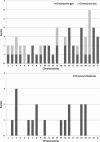Non-meiotic chromosome instability in human immature oocytes
- PMID: 23695274
- PMCID: PMC3895626
- DOI: 10.1038/ejhg.2013.106
Non-meiotic chromosome instability in human immature oocytes
Abstract
Aneuploidy has been a major issue in human gametes and is closely related to fertility problems, as it is known to be present in cleavage stage embryos and gestational losses. Pre-meiotic chromosome abnormalities in women have been previously described. The aim of this study is to assess the whole-chromosome complement in immature oocytes to find those abnormalities caused by mitotic instability. For this purpose, a total of 157 oocytes at the germinal vesicle or metaphase I stage, and discarded from IVF cycles, were analysed by CGH. Fifty-six women, between 18 and 45 years old (mean 32.5 years), including 32 IVF patients (25-45 years of age) and 24 IVF oocyte donors (18-33 years of age), were included in the study. A total of 25/157 (15.9%) of the oocytes analysed, obtained from three IVF clinics, contained chromosome abnormalities, including both aneuploidy (24/157) and structural aberrations (9/157). Independently of the maternal age, the incidence of abnormal oocytes which originated before meiosis is 15.9%, and these imbalances were found in 33.9% of the females studied. This work sheds light on the relevance of mitotic instability responsible for the generation of the abnormalities present in human oocytes.
Figures
References
-
- Delhanty JD. Inherited aneuploidy: germline mosaicism. Cytogenet Genome Res. 2011;133:136–140. - PubMed
-
- Angell RR. Predivision in human oocytes at meiosis I: a mechanism for trisomy formation in man. Hum Genet. 1991;86:383–387. - PubMed
-
- Pellestor F, Andreo B, Arnal F, Humeau C, Demaille J. Mechanisms of non-disjunction in human female meiosis: the co-existence of two modes of malsegregation evidenced by the karyotyping of 1397 in-vitro unfertilized oocytes. Hum Reprod. 2002;17:2134–2145. - PubMed
-
- Pujol A, Boiso I, Benet J, et al. Analysis of nine chromosome probes in first polar bodies and metaphase II oocytes for the detection of aneuploidies. Eur J Hum Genet. 2003;11:325–336. - PubMed
Publication types
MeSH terms
LinkOut - more resources
Full Text Sources
Other Literature Sources



